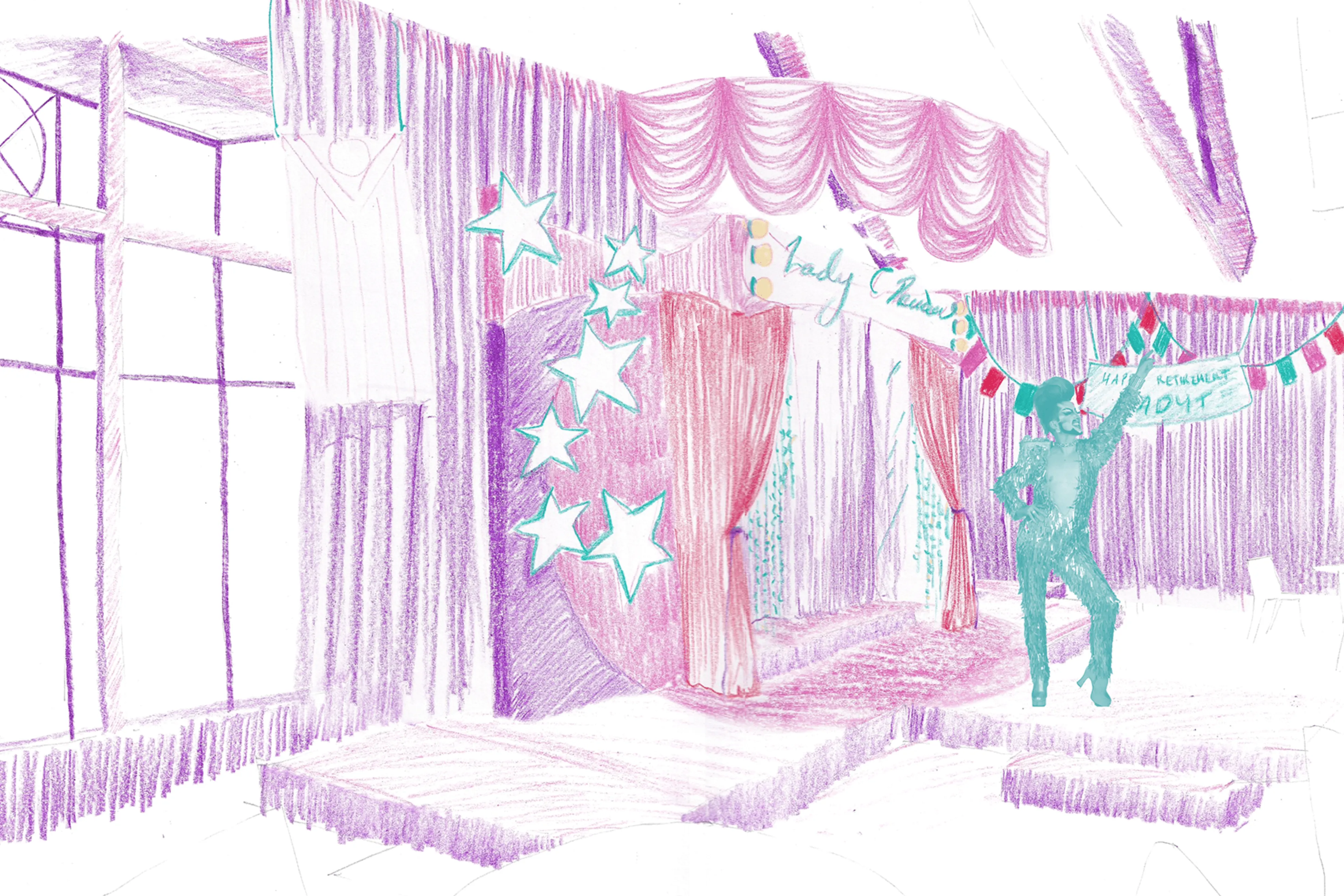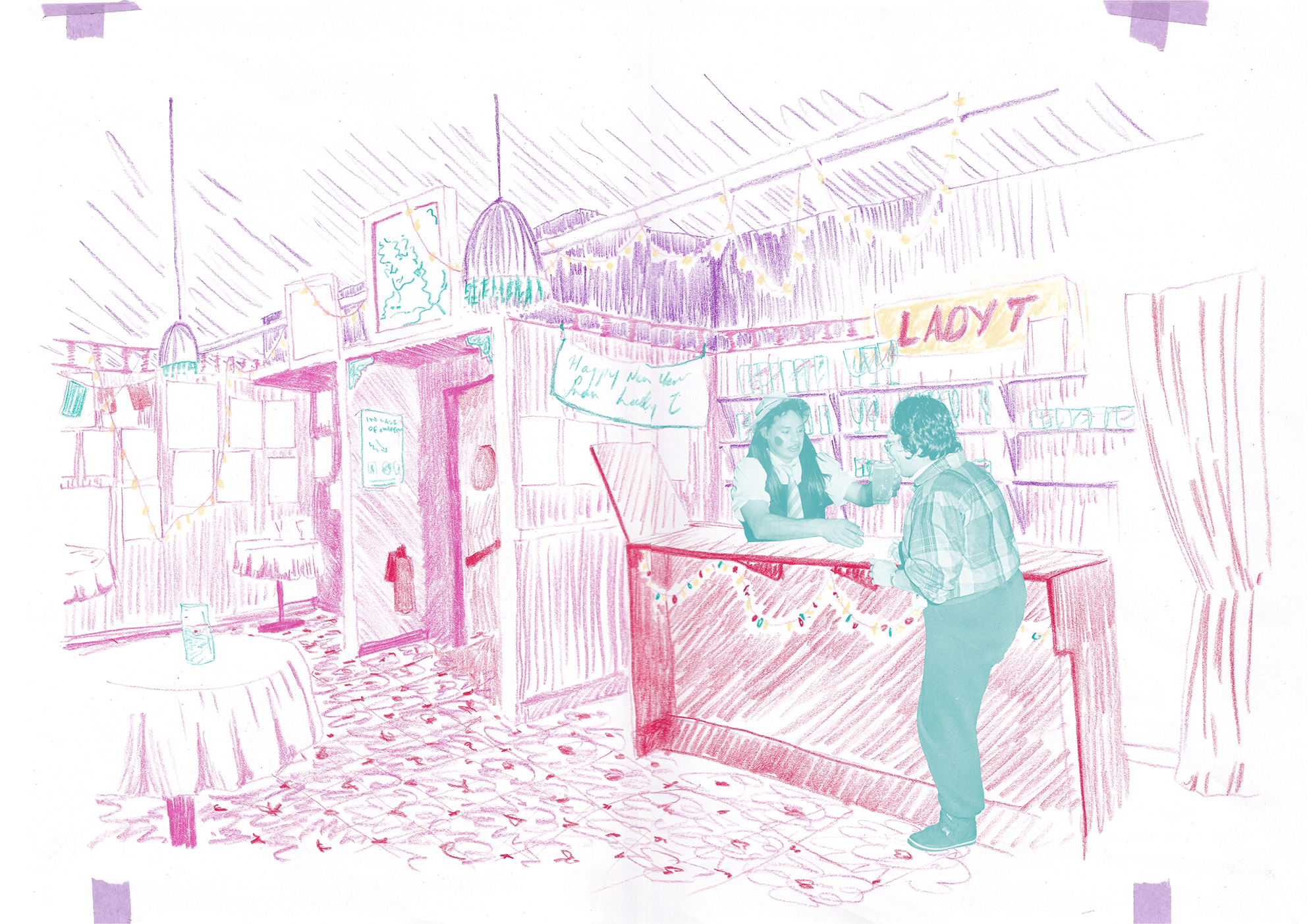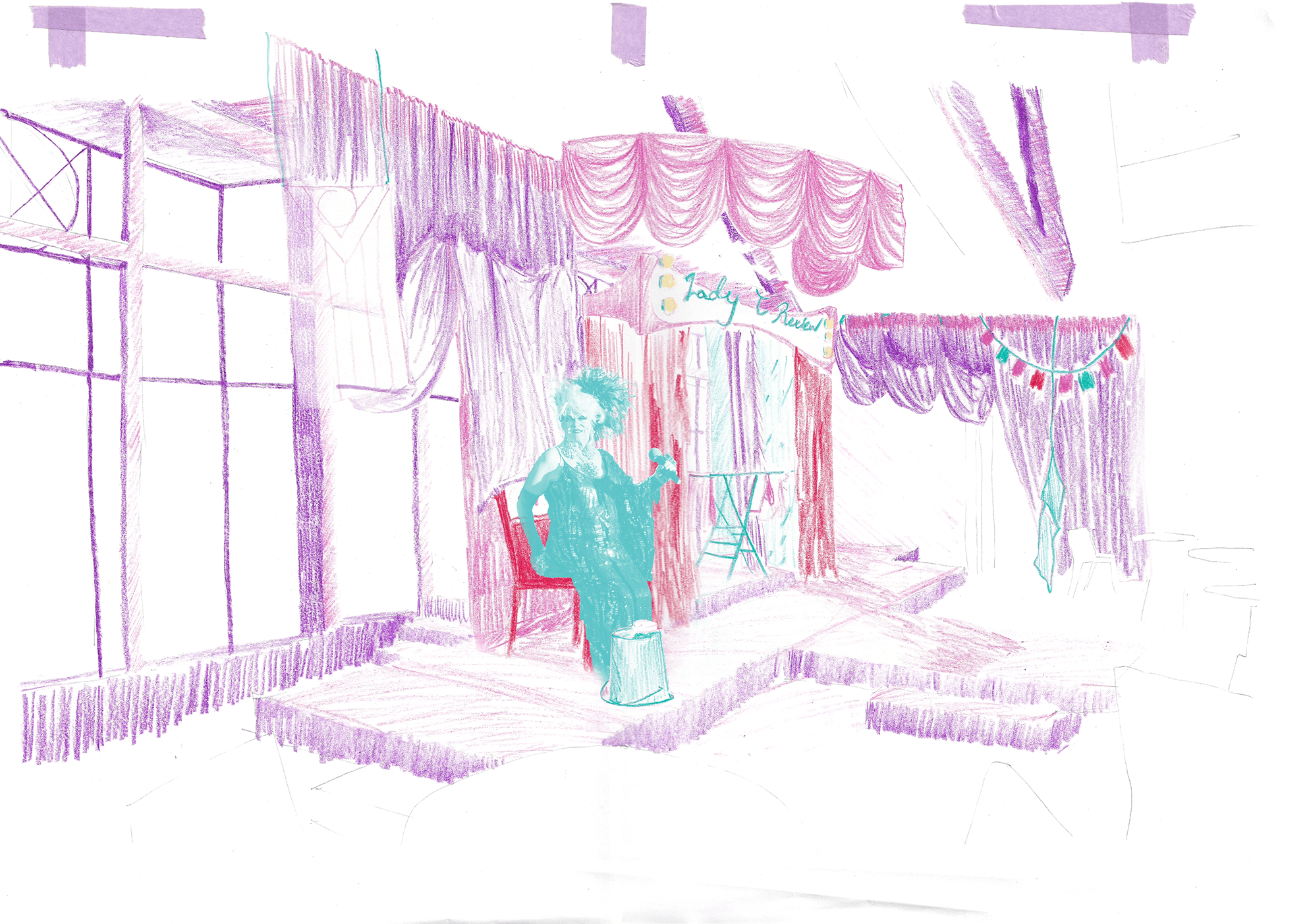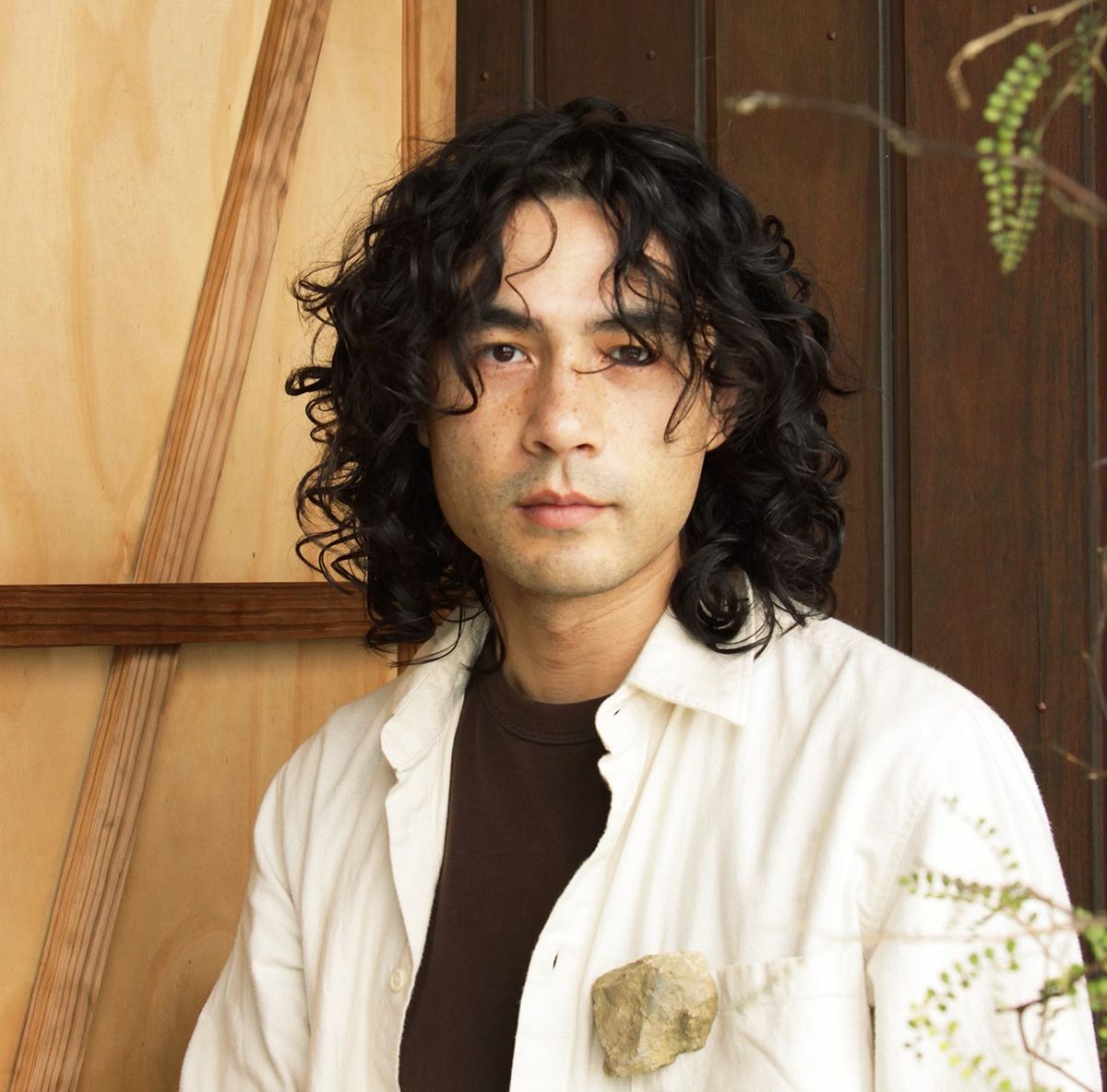Pulling queer space from the archive
Interdisciplinary designer Micheal McCabe considers how he turned to the past to imagine a future for queer venues in a recent theatre project.

D.R.A.G concept sketch (Micheal McCabe).
There is a large panel covered in images. They are of varying shapes, circles, rectangles and squares carefully cut and layered on top of one another. In the middle of the collage is a large cutting from a newspaper “big cat stalks the harbour at $1000 a day”. The rest of the panel is dense with bodies posed, candid, caught off guard and cropped for effect. There is a photo of six queens in high flash sitting around a timber veneer table with an open packet of ciggies, one lit and poised between the index and middle finger of Chrissy Witoko. There are queens in daytime drag at Begonia House and next to that a striking close up of Witoko, her eyes locked into the camera. Above her is Carmen, photographed in black and white beside two trailblazers in front of a floral curtain. These assemblies of memory gather lives from inside and outside of the queer coffee bar giving us glimpses into weddings, family gatherings and school photos. Hung originally on the walls of the Evergreen Coffee House, run by Witoko, there is a generosity within these panels that encourage us to look beyond the flattening gaze of nostalgia and to imagine full lives of joy, tv dinners, cruising through the Wellington harbour, struggle, difference and community.
The whakatauki Ka mua, ka muri asks us to turn our bodies, to face the past, and with our gaze fixed there move backwards into the future. A quarter century into this millenia it is easy to lament the state and number of queer spaces. Many have closed since I moved to Tāmaki Makaurau in 2012. My relationship to them has also changed as I’ve gotten older and perhaps with the distance of age I see them differently. In my thesis exploring queer spaces in Tāmaki Makaurau, I focused on this very loss due to gentrification, the rise of homonormativity, and the shifting priorities of venues as they became more “gay themed” than for gay people. This was written in the wake of the Pulse Nightclub shootings in 2016 that reminded us of the fragile safety of these venues – especially for those who sit within their edges and margins. Nearly a decade on, the spaces our communities inhabit continue to shrink and the certain rights won by LGBTQIA+ people (and those who are still fighting) sit again on a thin edge of a wedge.

Within venues like the Evergreen, The Balcony, Sunset Strip, The Cave in Te Whanganui-a-tara or Mojos, Staircase, Alfies, Surrender Dorothys, and The KG Club in Tāmaki Makaurau, the resilience of communities flourished. Through collective solidarity the challenges of our queer elders were able to be confronted. They were able to share a laugh, a durry, head out on a boat and live lives despite constant threats of violence. In the present we can connect back to these venues through the archive to seek guidance of what to do next.
In Aotearoa, a few institutions host archives related to LGBTQIA+ communities – Te papa, Alexander Turnbull, Sir George Grey, and Charlotte Museum. They are by no means only voices and other collections vast and small exist and continue to be built upon, some are informal, for example Facebook groups like “Late Lost Nightlife Wellington” and its counterpart “The lost nightlife of inner-city Auckland”. In these groups, people recount personal histories and memories of venues, parties and patrons. There is a special moment where members will post a photo and a flurry of comments collectively build upon one another – at first identifying, then describing and through this, reconnecting. Beyond the image the archivist, whether institutional or not, allows us to see the persistence of community and what happens beyond the moment caught in the closing of a shutter.

In Breathing Archive Jamie James’s, a photographer of Sydney’s Queer Scene, draws upon their personal archive to unpack the power of images as an embodied artefact. James articulates the need for archives to be activated and challenges us to “suck it in, embody it yourself, take it away, tell a story to someone else, pass it on, don’t make me hold it” in an Instagram video from October. There is a weight for our queer elders to retain the vast and intimate stories that have shaped our politics, culture and identities. Locally I remember seeing the work of Fiona Clark in 2016 at Artspace Aotearoa. The photos were glossy, personal and intimate. Each image welcomed you into her friendships and passing connections firmly turning our gaze towards our recent past. What Clark and James do so well is their ability to open up these intimate bonds, their queer kinships, to younger LGBTQIA+ communities through their art practice. These tactics allow queer histories to turn from ephemeral moments into collective knowledge that we can draw upon in times of struggle, in moments of joy and celebration.
When approached to design for D.R.A.G (Dressing Ressembling a God) by Daniel Williams, director and creator of the show, I thought back on my experiences working with archives in my early 20s. The “set” is an assemblage of traces of venues held within Kawe Mahara Queer Archives Aotearoa, in the backgrounds of Clark’s book Go Girls, and the public access documentary about Darcelle XV, who was until very recently the United States longest living drag queen who performed until her passing at 93. The past is present – built up in deliberate layers of queer aesthetics like the chic-nana core of Carmen’s, the DIY 70s glam of Mojos, and the recent infiltration of LEDs you might see in Caluzzi or Ivy Bar. Eras are stacked on top of one another, imaging a space that has survived through violent policing, legal reform, and gentrification.

The bar and theatre reorientate the patron who slips up the staircase from Queen Street and emerges through a lowered ceiling, ducking underneath portraits of past and present drag queens. Fiona Clark’s portraits of Miss K, Mamie, Carmen, and Chrissy Witoko are the first people who greet you when you enter the space. Turning back to the entrance are a field of frames that document the drag artists who are performing now at your local drag bar on a Saturday night. It was important for me that the space holds a sense of our current landscape and acknowledges its own role within the developing history of LGBTQIA+ people within Aotearoa.
The show begins “backstage”, as the performers, Adena Delights, Slay West and Hugo Grrrl, are getting ready for the night, slowly moving boxes of drag, shaving at a basin and fundraising to keep their club afloat. It collages together stories experienced by these performers; generational misgendering, decolonising your drag, the admin of running a venue, getting the bash, and the care they have for their fellow drag artists. On stage they activate their own embodied archive and allow us to share an evening within them so, perhaps we can, over a drink, after the show, share our own.

Michael McCabe is the Set & Props Designer for Silo Theatre’s D.R.A.G (Dressed Resembling A God), playing at Q Theatre from 13 November – 6 December.